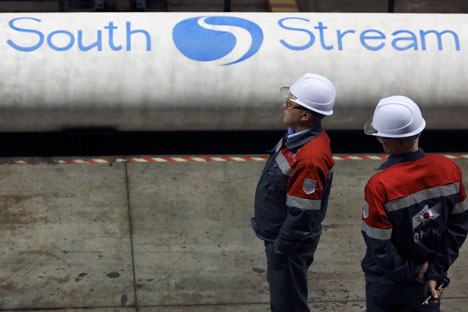Russia and U.S. prepare to fight for European gas market

At year-end 2015, Gazprom saw its share in the European market rise from 30 to 31 percent.
ReutersRussian gas giant Gazprom is boosting its presence in the European Union as it braces itself for a struggle with U.S. exporters of cheap shale gas for the European energy market, with the first tanker of American gas due to arrive in Europe as soon as March.
At year-end 2015, Gazprom saw its share in the European market rise from 30 to 31 percent. This slightly more than 3-percent growth may appear modest, but this is the first evidence of Russian gas increasing its presence in Europe, which has been actively diversifying its energy consumption over the past 10 years.
In addition, the company’s growth in individual countries looks much more impressive. It is as much as 37 percent in France, 17 percent in Germany, 12.6 percent in Italy, and 10 percent in the U.K.
Occupying vacant places
"Gazprom has filled a portion of the market share vacated by Algeria and Libya," said Georgy Vashchenko, head of Russian stock market operations at the Freedom Finance investment company.
"Production in Africa is falling, due to a reduction in investment caused by low prices and unstable political situation. Currently, [Africa] produces 30 percent less than five years ago."
At the same time, Norway cannot significantly increase its volume, while the Netherlands has seriously reduced production due to field decline.
However, the near future may see serious competition to Russian gas in Europe coming from the U.S, experts say.
The U.S. company Wood Mackenzie's study explicitly states that the E.U. could become a key buyer of U.S. liquefied natural gas, and by 2020, up to 55 percent of the country's total LNG production, or 32 million tons per year, will be shipped to Europe.
In other words, the U.S. will be ready to supply 44.16 billion cubic meters of gas (1 million tons of LNG = 1.38 billion cubic meters of natural gas) which accounts for approximately a quarter of all Russian gas deliveries to Europe (according to Viktor Zubkov, chairman of the board of directors of Gazprom, the company expects to deliver 160 billion cubic meters of gas to Europe in 2016).
In addition, 44.16 billion cubic meters of gas is about the entire volume of Russia's supplies to Germany (45.3 billion cubic meters of gas at the year-end 2015).
How expensive will American LNG be?
In January 2016, the U.S. was to dispatch the Energy Atlantic tanker carrying the first LNG supply for Europe from the Sabine Pass terminal in Louisiana.
However, for technical reasons, the delivery was postponed until late February-early March 2016 (most of the gas, 3.5 million tons, was chartered by the British company BG Group). In addition to Sabine Pass, four new LNG terminals are due to start operating in the U.S. in the near future.
Gazprom, however, is not taking competition with U.S. LNG seriously. According to the company's study, American LNG will cost consumers more than Russian gas supplied through pipelines.
"The total cost of U.S. LNG in 2016 is higher than the prices of European hubs," Gazprom said in a presentation to investors.
"The price includes transportation across the U.S., liquefaction, sea transportation and regasification in the UK."
Low gas prices also play into the hands of the Russian company.
At the moment, Gazprom calculates the possibility of reducing the average price of gas supplies to Europe from the budgeted figure of $199 per 1,000 cubic meters to $169 per 1,000 cubic meters.
For comparison, in 2015, Gazprom supplied gas to CIS countries at an average price of $243 per 1,000 cubic meters.
"Low gas prices are beneficial to Gazprom, since it has a cost advantage in LNG,” said analyst Sergei Ilyin of the Premier investment company, who pointed out that since LNG shipping is more expensive than supplying gas through pipes, the Russian company can safely reduce prices.
However, in the event of a rise in prices, the Russian monopoly will lose its advantage.
The price of gas depends on oil prices, and in the period of high prices of hydrocarbons, the consumption of gas in Europe fell by almost 50 billion cubic meters due to competition from coal.
Subscribe and get RBTH best stories every Wednesday
All rights reserved by Rossiyskaya Gazeta.
Subscribe
to our newsletter!
Get the week's best stories straight to your inbox

